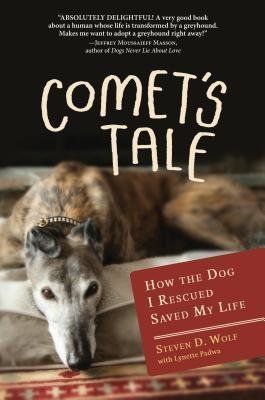
"A greyhound? Are you crazy? Mon Dieu! What are you going to do with one of those skinny, hyper, racing dogs? You have two perfectly sweet golden retrievers and three beautiful daughters right now who could stand a lot more of your attention." The fiery response was probably understandable, given that I had trouble walking, was often in pain, and was living alone in Arizona, 1,300 miles from the frustrated Frenchwoman - my wife - who was back home in Nebraska taking care of those daughters and dogs. I had come to Sedona for health reasons and we were separated for months at a time by 20 hours of hard driving.
To be honest, despite my particular situation, Freddie's view of greyhounds was not unusual and had I not had a fortuitous encounter with a group that rescued abandoned racing greyhounds, my attitude about the breed probably would have closely mimicked Freddie's. And, anyway, by the time of our conversation, I had already adopted the cinnamon-and-black striped brindle named Comet, who was the complete and total opposite of any clichéd notion of greyhounds.
While I was writing Comet's Tale: How the Dog I Rescued Saved My Life [Algonquin, $23.95], I contemplated the reasons for this canine dichotomy, the conflict between stereotype and reality.
My search for an answer started with the oft repeated: Greyhounds aren't pets; they're just for running in circles at a racetrack. After all, how many children have you heard singing How Much is That Doggy in the Window? after seeing a greyhound at the pet store? And when was the last time a litter of greyhounds was advertised for sale in the pet section of your local newspaper?
But tens of thousands of greyhound puppies are born every year. A miniscule percentage of those dogs are bred for shows, like the Westminster Dog Show. The vast majority, estimated to be more than 20,000 puppies per year even with so many less dog tracks from the heydays of the 1980s through the 1990s, come into this world on breeding farms. There, kennels are equipped with long-chained runs, giving the dogs as much opportunity as possible to learn only one thing--how to run fast. At about 15 to 18 months of age, these greyhounds are sent to tracks where they spend all their time in cages between races. Not much room in that life for a dog to develop a charming personality.
This is not to say that many of these dogs are not cared for, fed and given their shots on time. In fact, many breeders will tell you unequivocally that they love their greyhounds. The conundrum, though, is that the numbers of these dogs that must be bred to satiate the racing industry's demands necessitates greyhounds be raised and treated more like prize livestock than family pets. And as a former Iowa farm boy, I can tell you no matter how much the 4-H steer was loved, it wasn't going to stay with the family after it reached hamburger weight. Greyhounds are not raised in farm kennels in order to become cuddly, loving house companions, either.
But, oh, let me tell you from experience, that's exactly what they can be. Instead of being euthanized or sold for medical research as in former days, many discarded greyhounds--those who don't make it as winners-- are now finding their way to one of the three hundred groups who prepare them for adoption. Greyhound adopters will have to teach their new family members how to walk, climb up stairs, play with children, not to be afraid of the neighbors' dogs, and how to walk across wood floors without legs splaying outward as if sliding on ice. Comet, like most greyhounds, was super smart, and quickly learned how to be around people, to negotiate her way through the house and outdoors. She also learned to reign in her insatiable curiosity once in a while; it really wasn't necessary to enter every neighbor's yard each and every time they moved a lawn chair or changed the landscaping. And the nose thump given to a kitty safely ensconced in the owner's arms wasn't really the way to make friends. Despite that feline faux pas, Comet pretty much charmed anyone she met. Just ask Freddie. After only one weekend with Comet, Freddie would no longer tolerate even joking references to any negative misconceptions of greyhounds.
Inevitably, a greyhound guardian becomes a passionate advocate for the breed. Comet was serene, unassuming, and affectionate. Her demeanor was often more Zen than dog. She was the best companion this man could ever have. And Freddie's initial worries that I would not be able to take care of Comet proved somewhat ironic: As my health deteriorated, I eventually trained Comet to become my service dog. She not only took care of me, she ended up saving my life. But that's a story for another day.